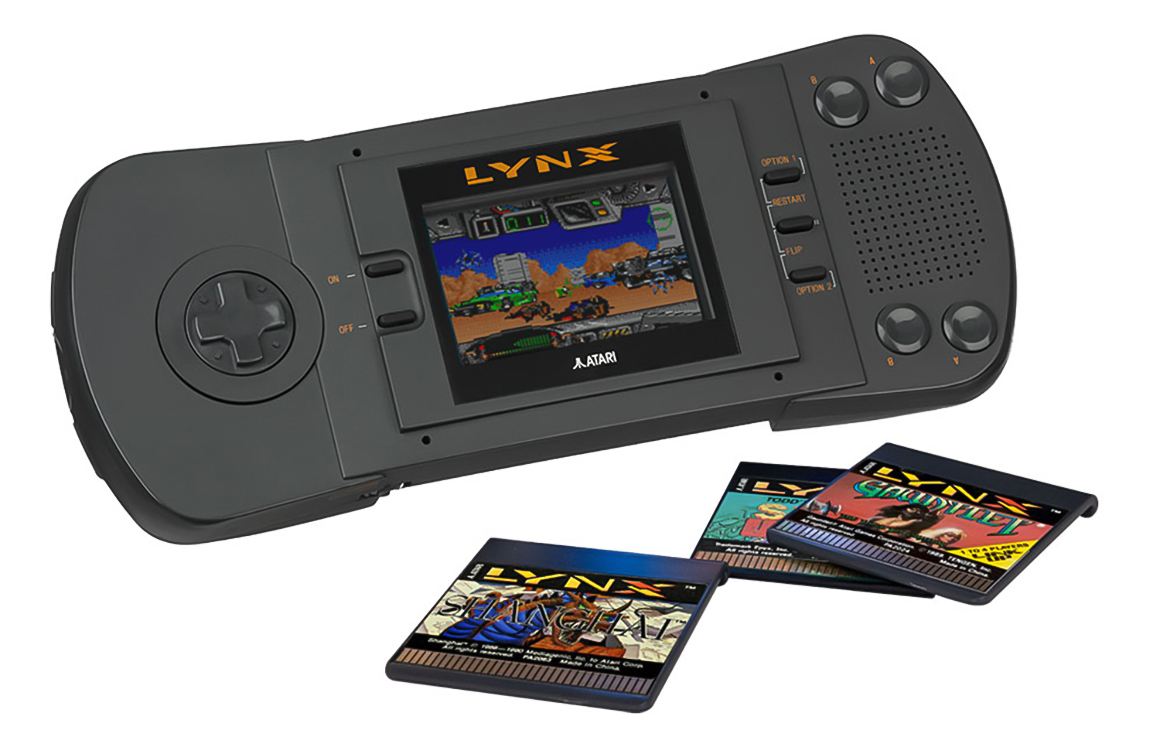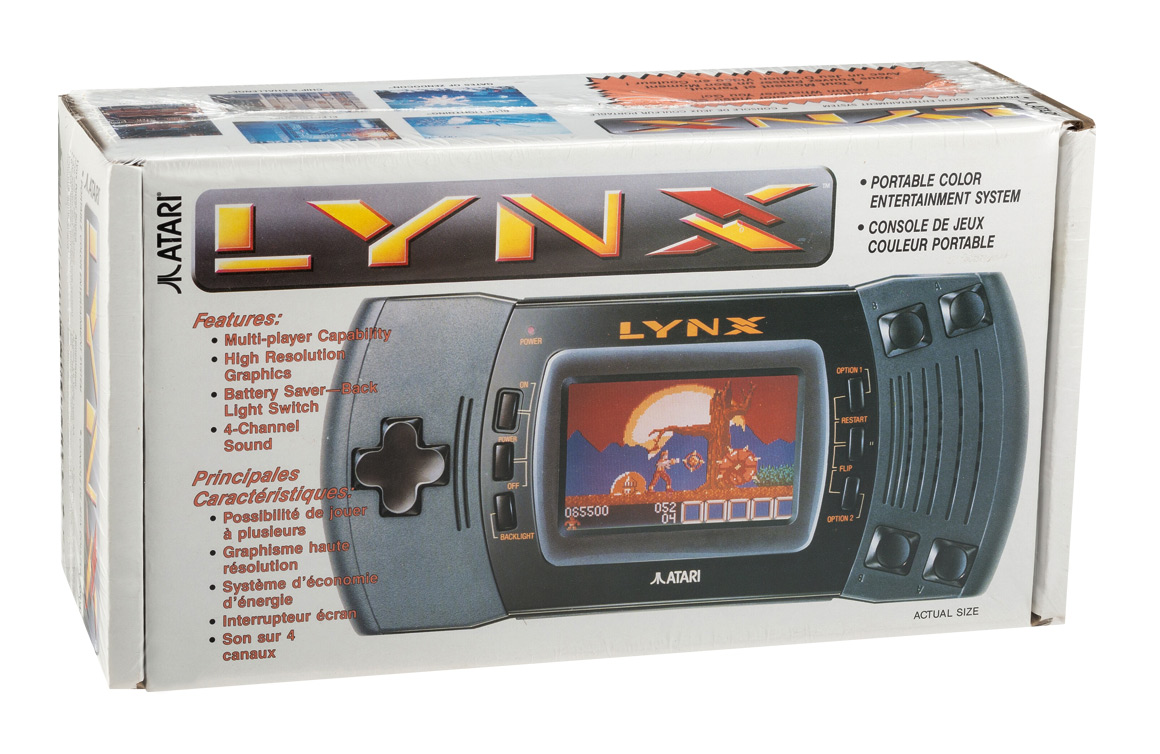In September 1989, Atari released the Lynx.
A revolutionary handheld that looked to take sales away from the Nintendo Game Boy, the Lynx was a truly exotic piece of gaming hardware. Featuring a rather futuristic look that put its brick-like competition to shame, it offered consumers everything from advanced graphics to a backlit screen and even an ambidextrous layout. Additionally, not only was it the world’s first colour handheld, but it was also one of the very first 16-bit gaming consoles to hit the market — and the first 16-bit handheld besides.
Originally developed by Epyx as the Handy, the unit was the brainchild of former Amiga designers R.J. Mical and Dave Needle after their manager had asked them to come up with a new portable gaming system. Atari would eventually come along to both fund and rename the project after efforts to market the system to Nintendo had failed. Under a new agreement, Epyx was to handle software development on the Lynx, while Atari would manufacture the hardware. However, with Epyx filing for bankruptcy protection before the end of 1989, full responsibility for the console fell solely to Atari. And, they’d be bringing it to market behind both the fresh-faced SEGA Genesis and the immensely popular Game Boy.
To most, this may have looked like a suicide mission. After all, Nintendo had pretty much single-handedly revitalized the North American gaming industry with the launch of the Nintendo Entertainment System just a handful of years earlier. Thanks to such hit titles as Super Mario Bros., Metroid, and The Legend Of Zelda, the Japanese juggernaut had shown the world that video games were not simply some passing fad but a glimpse into the future of entertainment. At the same time, despite the lacklustre performance of the Master System, SEGA was quickly gaining momentum in the marketplace and showing the world that the Genesis was something set to soon give Nintendo a serious run for their money. However, at least on paper, it looked as though the Lynx might stand a chance.
Yes, as mentioned, it was one of the very first 16-bit gaming consoles in the world. And yes, it was also the first colour handheld on the market. However, that was just the tip of the iceberg.
The Atari Lynx sported an impressive list of additional features not offered by the competition. The ambidextrous layout of the unit allowed the console to be played either right-handed or left-handed and the screen could be flipped to accommodate either configuration easily. Certain games could even be played vertically if so desired. The Lynx also featured a backlit 3.5-inch LCD screen with a resolution capable of displaying up to 16 colours per scan line. It also had the ability to network with up to 15 other units via the included Comlynx system and is cited as the very first gaming console with hardware support for the zooming and distortion of sprites. Yes, when it came down to hardware, the Lynx did in fact have somewhat of an edge over the Game Boy.
However, not all that glitters is gold. In addition to being a battery-eater, the LCD screen on the Lynx was more than a little washed out and hard to see. Yet, keeping in mind that nothing like this had been done before the console’s release, there is no denying that the Lynx was an idea ahead of its time.
Despite its array of features, Atari had difficulty attracting third-party developers to the system. However, during its six-year shelf life, a total of 73 games would be released for the Lynx and include such strong entries as Blue Lightning, Chip’s Challenge, Desert Strike: Return To The Gulf, RoadBlasters, S.T.U.N. Runner, Todd’s Adventures In Slime World and Warbirds to name but a few.
Initially, sales for the Lynx were strong. Atari reported that they had sold 90% of the units shipped to stores for launch in the United States. The following year, an additional 500,000 units were said to have been sold. However, this celebration was short-lived.
In May 1991, SEGA launched the Game Gear. A portable gaming system with a compact design, higher resolution colour screen and a significantly larger library of video games, it quickly began to chip away at Atari’s sales numbers. This despite having both a shorter battery life and a higher sticker price than the $179.99 USD MSRP of the Lynx. Coupling this with the fact that they had never been able to overtake the numbers generated by the Nintendo Game Boy, Atari went back to the drawing board.
Just a few months after the launch of the Game Gear, Atari introduced the Lynx II.
Spearheaded by a new marketing campaign, this new handheld console featured slightly improved hardware, better battery life, and a sleeker look. In addition to receiving a clearer backlit colour screen and a power save option, the Lynx II also featured rubber hand grips and a new headphone jack wired for stereo. New packaging was also designed, making this new Lynx available without any accessories and dropping the console’s price tag down to a much more affordable $99 USD. Sales would improve slightly, however, the handheld market continued to be dominated by the competition.
In 1993, amid declining sales, Atari began to shift focus away from the Lynx in favour of their Jaguar home console. Support for the Lynx was formally discontinued in 1995, with Atari finally terminating all internal game and hardware development later that same year. In total, some 3,000,000 units were sold when it was all said and done. A far cry from the 10,000,000 plus of the Game Gear and the simply staggering 18,600,000 of the original Nintendo Game Boy.
Since then, the Lynx has gone on to enjoy a resurgence in popularity. There is an active online community surrounding the console and numerous modifications and upgrades are now available to improve upon everything from sound quality to screen clarity. If you’d like to add one to your collection, loose examples in good shape can be purchased via the secondary market for close to the original price while boxed units with all the included paperwork are fetching upwards of $400 USD.
Yes, commercial failure though it may have been, it seems the world has finally come around to accepting the Atari Lynx.
Note: If you buy something using the eBay link in this story, we may earn a small commission. Thank you for supporting independent toy journalism!


